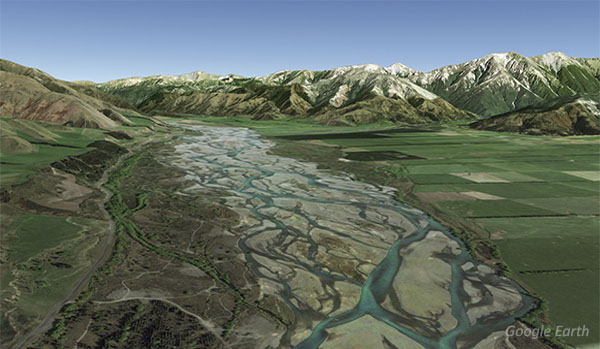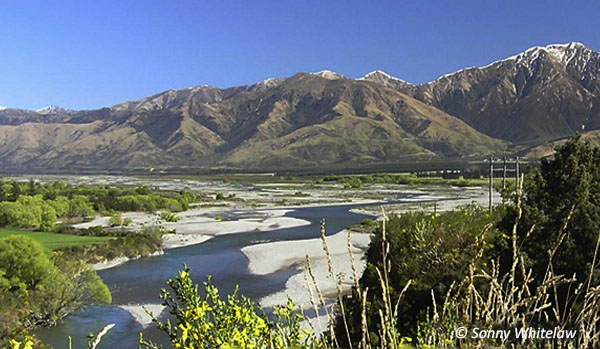Waiau River
Originating in the Spenser Mountains, the Waiau River has the second largest catchment (3,310 km2 click to see interactive map) of North Canterbury’s rivers.

Several tributaries feed into the river. The Lewis River, which parallels sections of the main highway from Canterbury to the West Coast across the Main Divide, the Doubtful River, which joins the Waiau at Amuri Pass, the Hope River, and the Hanmer, Mason, and Leader Rivers. The landscape of the headwaters upstream of the Waiau-Hope junction was glaciated until around 10,000 years ago, providing the rich supply of gravels need for a braided river.
The east-west sections of the Hope, Waiau, and Hanmer Rivers lie along the Hope Fault, a major geological feature of the South Island. At Glen Wye Station, the 1888 earthquake broke and displaced fences 2.5m horizontally across the fault. This was the first conclusive evidence in the world of horizontal fault movements.
Biodiversity & Cultural Significance
Important Bird Areas on the Waiau River: links to 6-page PDF file that includes maps, habitat types, and threats relevant to the larger Rakaia catchment. This document was extracted from Forest & Bird’s 177-page 20Mb file on all rivers, lakes, and coastal areas.
Extract from the Hurunui and Waiau Regional Plan: The takiwā (geographical interests) of two Ngāi Tahu Hapū (sub tribes) straddle the Hurunui and Waiau river catchments: Ngāti Kuri and Ngāi Tuahuriri. Ngāti Kuri’s interest extends from Parinui o Whiti (White Bluffs) in the north to the Hurunui River in the south, east from the Main Divide out to sea as far as the eye can see. Ngāi Tuahuriri’s interest extends from the Hurunui River in the north to the Hakatere/Ashburton River in the south, east from the main divide and out to sea as far as the eye can see.
The mauri of the Waiau and Hurunui rivers represents the essence that binds the physical and spiritual elements of all things together, generating and upholding all life. All elements of the natural environment possess a life force, and all forms of life are related. Mauri is therefore a critical element of the spiritual relationship of Ngāi Tahu whānui with the rivers.
For Ngāti Kuri the Waiau-uha (the Waiau River) is connected through whakapapa to Waiau-toa (the Clarence River). The river in legend is the female sprit of the inland mountains, and the Waiau-toa is the male. Moving from the Spencer Mountains and Miromiro (Jollies pass), where the Waiau meets the Waiau-toa, the waters become separated. As the Waiau-uha laments the parting, her tears fall as warm rain to melt alpine snows, swelling both rivers to massive proportions. The water flow from the Waiau River is therefore an important factor in the ecological health and bio-diversity of the river and coastal resources.
Both rivers provide important habitat for native fish and have key trout, salmon and whitebait fisheries. Both rivers and some of the larger tributaries also provide important habitat for braided river birds and the headwaters provide habitat for threatened species such as blue duck. The rivers are used for a variety of water based recreation activities including kayaking and jet boating. These values can be degraded if the flow in the river is insufficient, changes occur to the natural frequency of floods and freshes, water quality deteriorates or the river is modified by structures. Larger freshes and floods in these rivers are also important for scouring and flushing periphyton accumulations, mobilising gravel, triggering flow-dependent life stage processes such as fish migration and removing exotic vegetation from gravel riverbeds.
Conservation activities
- 2023: Waiau Toa/Clarence and Wakaputawatea/Acheron River tarapirohe/black-fronted tern monitoring project – 2022/23 operational report (PDF).
- 2019 (DOC): Black-backed gull control on the Hurunui and Waiau Rivers
- 2016/17: Under the Braided Rivers Partnership Programme, BRaid installed traps around a colony of black-fronted terns at Shark Tooth. The traps were checked by Amuri Jet over the breeding season. Diary notes detailing the outcome and recommendations are available here.
- A Waiau River Care Group formed in 2013 to help protect populations of black-fronted terns and black-billed gulls that nest on the riverbanks near Waiau township, however, this group is no longer active.
Bird surveys
- 2022: Waiau River bird survey
- 2018: Mason River bird count
- 2018: Waiau River bird survey
- 2017 + 2009 +2010 + 2016: Waiau surveys as xls spreadsheets
- 2016: Waiau River bird survey
- 2008-2010: Waiau surveys as xls spreadsheets
- 2008: Braided River Bird Surveys Of The Waiau River & Eight Smaller Canterbury Rivers, Spring

Water flow
The river flow regime is diverse and typical of glacial fed rivers in the Canterbury region. Its main source of flow is from precipitation and snowmelt in the headwaters .
- River Report 24-hour Infoline: river flows (updated twice daily), rainfall, sign up for text alerts
- Catchment map and monitored sites include scientific indicators for water quality (LAWA: Waiau River)
References & Research
- ECan document library: enter ‘Waiau River’ in the ‘keywords‘ search field
- DOC catalogue of scientific publications: enter the relevant search terms in the ‘search’ dialogue box. You may need to vary your search, for example ‘black stilt’ gives far more results than ‘kaki’ or ‘kakī’
- See Rivers for a more comprehesive list of braided rivers research and reference material
